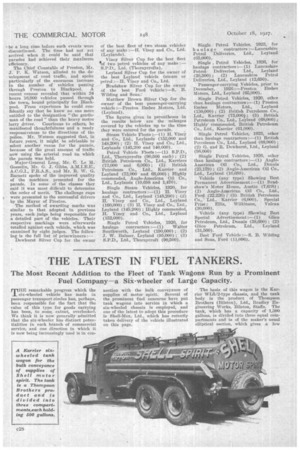THE LATEST IN FUEL TANKERS.
Page 50

Page 51

If you've noticed an error in this article please click here to report it so we can fix it.
The Most Recent Addition to the Fleet of Tank Wagons Run by a Prominent Fuel Company—a Six-wheeler of Large Capacity.
THE remarkable progress which the six-wheeled vehicle has made in passenger transport circles has, perhaps, been responsible for the fact that the value of this type for goods carrying has been, to some extent, overlooked. We think it is now generally admitted that the six-wheeler has distinct potentialities in each branch of commercial service, and one direction in which it is now being increasingly used is in con
nection with the bulk conveyance of supplies of motor spirit. Several of the prominent fuel concerns have put tank wagons into service in Which a six-wheeled chassis is employed, and one of the latest to adopt this procedure is Shell-Mex, Ltd., which has recently taken delivery of the vehicle illustrated on this page. The basis of this wagon is the KarHer WL6/2-type chassis, and the tank body is the product of Thompson Brothers (Bilston), Ltd., Bradley Engineering Works, Bilston, Staffs. The tank, which has a capacity of 1,500 gallons, is divided into three equal compartments and is of the maker's usual elliptical section, which gives a low centre of gravity and an even distribution of the load. Each compartment of the tank is provided with a manhole, incorporated on the lid of each being the filler, dip and vent pipes, as well as the operating gear for the valves. All these parts are totally enclosed in an bluminium cover, and the lids are equipped with a static eliminator lock so that it is impossible to open a compartment of the tank until the earth connection is made.
The valves of the tank are of a patent design, being drip-proof and provided with hardened stainless-steel spherical valve and seating, so arranged that they can be cleaned out without disturbing the pipe-line or opening up the tank, it merely being necessary to take off the removable plate from beneath the valve.
The spirit is drawn off from the two front compartments of the tank at the near side, and at the back in the case of the compartment at the rear, and special locked, gun-metal, straightthrough-type cocks are fitted.
A unique feature of the vehicle is the method employed for mounting the tank. This takes the form of a pair of mild-steel box-type feet which are bolted to tees, these being welded to the body of the tank and carried in east-steel brackets and slides, so arranged that adjustments can be made for alignment, with a rubber insert between the feet and the brackets. This is secured to the chassis by means of four bolts on each side, these passing outside the chassis members and thus avoiding the need for drilling the chassis frame and, at the same time, making the unit quickly detachable.
Two steel tubes on each side of the tank are provided for carrying the lengths of hose, and these tubes are cut away diagonally at the rear end and fitted with cast-aluminium covers, thus preventing dust from reaching the interior of the hose. The driver's cab is built on pleasing lines and, apart from 'being of ample proportions; is fitted with large side windows and rear windows, the latter being curved to the same radius as the tank. At the rear of the cab, steps and hand-rails give easy access to the ladder which leads to a platform running the full length of the top of the tank. At the rear of the outfit is a hinged bumper bar, the brackets for which form a carrier for the spare wheel and tyre.
The main details of the chassis to which the body is fitted have been referred to in our columns on several occasions, but it may be as well to refresh the memories of our readers with the outstanding features. A sixcylindered engine is employed, and this develops 61 h.p. at a normal speed of 1,250 r.p.m. Its bore is 100 mm. and the stroke 140 mm. The clutch is of the adjustable cone type, and the gearbox provides four speeds forward. The twin axles at the rear are worm-driven.












































































































